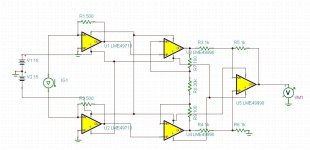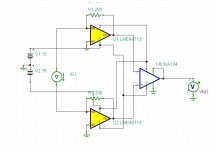Joachim already mentioned the LME49713 earlier in the thread. I've built a headphone amp around this op-amp and really like it!
OK! I missed that obviously. It looks perfect and there's a spice model for it! thank you!
Dirk, I have quite a few of the TO-99 version and would be willing to donate 4x of them to the cause. I can adapt them to DIP format if needed. I can also purchase the SOIC version for pretty cheap and put them on adapters.
My interest here is that I built a PCM1974A DAC about 4 years ago and it still sits without an I/V stage.
My interest here is that I built a PCM1974A DAC about 4 years ago and it still sits without an I/V stage.
also... its not a current amp but how about LME49990 some impressive figures except for the slew rate. The 49990 looks better than the AD797 which is used in the ESS reference DAC IV stage to fo THD at the Dac output about 130db+
LME49990
THD+N (0.00001%)
noise density (0.9nV/ √ ^Hz)
slew rate of ±22V/μs
CMRR (137dB)
PSRR (144dB)
Precision Amplifier - Low Noise - LME49990 - TI.com
LME49990
THD+N (0.00001%)
noise density (0.9nV/ √ ^Hz)
slew rate of ±22V/μs
CMRR (137dB)
PSRR (144dB)
Precision Amplifier - Low Noise - LME49990 - TI.com
Dirk, I have quite a few of the TO-99 version and would be willing to donate 4x of them to the cause. I can adapt them to DIP format if needed. I can also purchase the SOIC version for pretty cheap and put them on adapters.
My interest here is that I built a PCM1974A DAC about 4 years ago and it still sits without an I/V stage.
That's a generous offer, thanks.
I have used Pad2Pad and I like it a lot. If you want to collaborate on a design then I can help. TO-99 is fine with me. I'm confident that we can merely substitute the LME49713 for the NE5534 with no issues, though I should take a close look at that.
also... its not a current amp but how about LME49990 some impressive figures except for the slew rate. The 49990 looks better than the AD797 which is used in the ESS reference DAC IV stage to fo THD at the Dac output about 130db+
LME49990
THD+N (0.00001%)
noise density (0.9nV/ √ ^Hz)
slew rate of ±22V/μs
CMRR (137dB)
PSRR (144dB)
Precision Amplifier - Low Noise - LME49990 - TI.com
Yes, but we need current feedback because this is an IV converter and the DAC output is a current. At least, this is my latest idea.
We just need to pick a good instrumentation opamp now.
The INA114 looks like a good choice for an instrumentation amplifier:
http://www.ti.com/lit/ds/symlink/ina114.pdf
Though I have not modeled it yet. I think the noise is a little high.
http://www.ti.com/lit/ds/symlink/ina114.pdf
Though I have not modeled it yet. I think the noise is a little high.
several someones here really should read Hawksford's paper on DAC I/V - he does talk about op amp requirements, topology improvements - despite that fact that the only discussion you see is of his discrete I/V
http://www.essex.ac.uk/csee/researc...Current steering transimpedance amplifier.pdf
many CFA have poor distortion specs, CFA can't use feedback C to implement 1st reconstruction filter pole
I keep pointing to ADA4897, other new linearized front end fast op amps as having "game changing" unique combination of specs suited to DAC I/V circuit demands
Spice op amp macromodels really don't do a very good job, output stages are near complete fiction, I/V circuit performance needs careful interpretation - just looking at the output distortion spectrum isn't sufficient when op amp output asymmetry, distortion, high frequency Z, DAC compliance, output Z distortions, Delta-Sigma rising noise shaping output spectrum aren't modeled at all
http://www.essex.ac.uk/csee/researc...Current steering transimpedance amplifier.pdf
many CFA have poor distortion specs, CFA can't use feedback C to implement 1st reconstruction filter pole
I keep pointing to ADA4897, other new linearized front end fast op amps as having "game changing" unique combination of specs suited to DAC I/V circuit demands
Spice op amp macromodels really don't do a very good job, output stages are near complete fiction, I/V circuit performance needs careful interpretation - just looking at the output distortion spectrum isn't sufficient when op amp output asymmetry, distortion, high frequency Z, DAC compliance, output Z distortions, Delta-Sigma rising noise shaping output spectrum aren't modeled at all
Last edited:
INA129?
Or just make your own with three good op-amps? That would only be 10 op-amps total for the output stage... lol.
That one has lower noise @ 8~10 nV/Hz1/2.
We may have to use 3 opamps for our own instrumentation amplifier to get lower noise. If so, then the previously mentioned LME49990 (x3) would be a good choice. I'm not afraid of SOIC devices. I can start modeling in Tina when I have time. Anyone else want to start modeling also?
someone here really should read Hawksford's paper on DAC I/V - he does talk about op amp requirements, topology improvements - despite that fact that the only discussion you see is of his discrete I/V
http://www.essex.ac.uk/csee/researc...Current steering transimpedance amplifier.pdf
Since you have apparently already read it, can you supply us with your insights from it? Are we going in the wrong direction according to the paper?
several someones here really should read Hawksford's paper on DAC I/V - he does talk about op amp requirements, topology improvements - despite that fact that the only discussion you see is of his discrete I/V
http://www.essex.ac.uk/csee/researc...Current steering transimpedance amplifier.pdf
many CFA have poor distortion specs, CFA can't use feedback C to implement 1st reconstruction filter pole
I keep pointing to ADA4897, other new linearized front end fast op amps as having "game changing" unique combination of specs suited to DAC I/V circuit demands
Spice op amp macromodels really don't do a very good job, output stages are near complete fiction, I/V circuit performance needs careful interpretation - just looking at the output distortion spectrum isn't sufficient when op amp output asymmetry, distortion, high frequency Z, DAC compliance, output Z distortions, Delta-Sigma rising noise shaping output spectrum aren't modeled at all
I read that particular paper years ago. I must admit that for all my admiration of Prof. Hawksford, I found neither the discrete nor the IC op-amp based circuits compelling upon simulation. The problem I have with the discrete current-conveyer design is that while it features an interesting error canceling topology, it still utilizes a feedback-loop. I was disappointed that it wasn't designed as an open-loop solution. Regarding the multiple-feedback, multiple device IC op-amp approach, which I recall as intended to minimize the slew-rate experienced by any single op-amp, I was never able to get my simulation to exhibit stable behavior. Which, of course, may only have been due to my implementation or simulator. However, on top of that, Prof. H. still recommends the inclusion of a passive low-pass input filter to limit bandwidth and slew-rate. Such a passive input filter could easily render the whole multi-feedback, multi-device topology and it's attendant complexity, unecessary. Interesting stuff overall, but not as compelling as I had hoped, with all due deference to the esteemed and much admired (by me) Professor Hawksford.
Last edited:
Ken, what do you think of this idea of replacing the NE5534's in the TI schematic with a CFB opamp like the LME49713? Also, what about the idea of replacing the output opamp with an instrumentation opamp (or 3 of some other opamp)? This is what makes sense to me, but I don't have enough experience to know for sure. I have not had time to model this in Tina SPICE.
Dirk, I must admit that I stopped experimenting with IC op-amp based I/V circuits quite some time ago. I achieved by far the best sound quality via a simple passive (resistor) I/V which is subsequently A.C. coupled directly (without any intervening active circuit) to my discrete FET based linestage for voltage amplification. Although, the linestage itself is functionally a discrete op-amp. The transparency of this configuration far surpassed the current-feedback IC op-amp based I/V converter I was using until then. My FET linestage has plenty of gain for this application (the fullscale signal from the DAC is about 0.4VRMS), so an active I/V stage located on board the DAC would be one active stage too many. So, I couldn't honestly offer you an opinion on the latest current-feedback IC op-amp based I/V implementations.
Last edited:
Here it is with a line receiver instead of an instrumentation opamp. Performance is not as good, but the circuit is far more simple. The input impedance at the NN pins is extremely low, far lower than anything I've seen before, like 0.001 ohm.
OK, wait a minute, that line receiver is nothing special. Duh. Let me redo this one.
OK, wait a minute, that line receiver is nothing special. Duh. Let me redo this one.
Attachments
Last edited:
- Status
- This old topic is closed. If you want to reopen this topic, contact a moderator using the "Report Post" button.
- Home
- Source & Line
- Digital Source
- The pcm1794a datasheet I/V converter and how to improve it.

